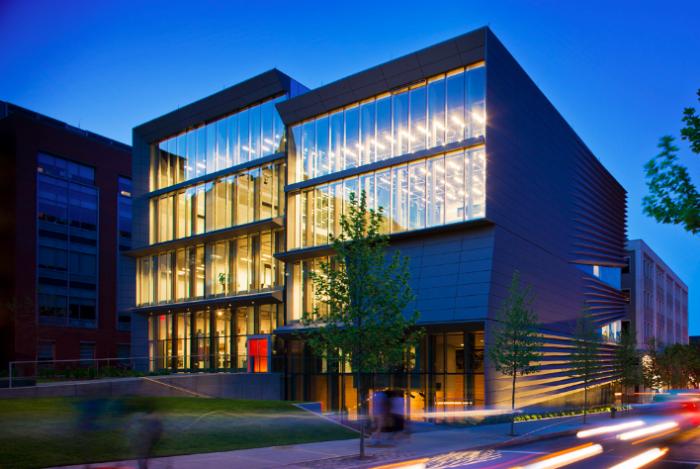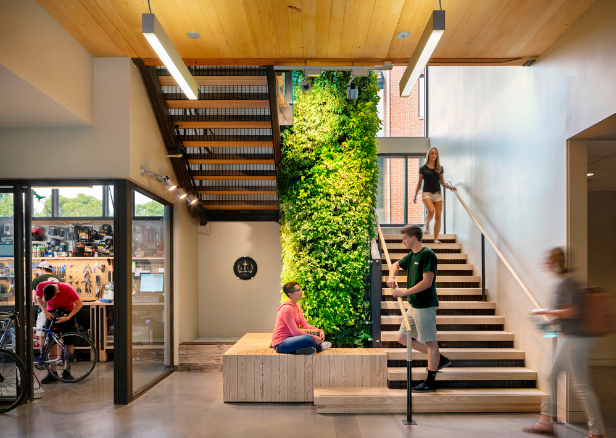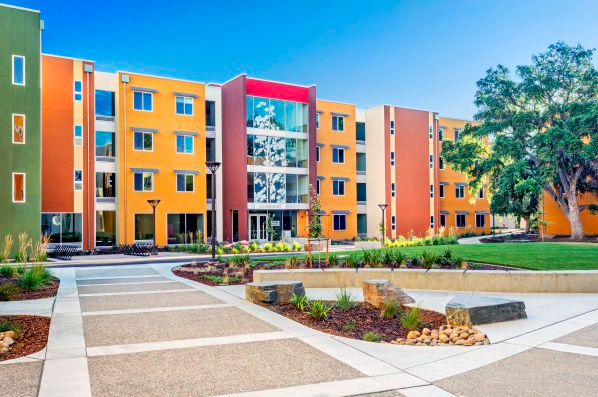
Incorporating sustainable practices into education is a great way to promote the importance of green building and sustainable living in the lives of the new generation. On college campuses this is especially prominent, as young adults begin their independent lives, forming new habits and opinions. A ‘green campus’ is something to strive towards for these reasons, as well as the positive effect a green campus can have on environmental and student well-being. While greening an entire campus may be a difficult task, there are simple initiatives many schools can implement, encouraging students, professors, and faculty alike to think green. University of California Davis, Brown University, University of California Berkeley, and Colorado State University are a few examples of schools leading the way in sustainability both on the large and small scale levels.
A common goal of many college campuses is becoming carbon neutral. Some universities have taken initial steps towards this goal, while others have set a hard date by which they hope to have achieved neutrality. University of California Davis and the University of California Berkeley have both pledged to be Carbon Neutral by 2025. This may seem like a bold move, but with further research it is clear that schools pledging carbon neutrality already have practices and initiatives in place making these goals more reachable.

The Pavillion at Laurel Villiage, the first LEED Platinum building at CSU.
One of these practices is making sure any new construction on campus is sustainable and complies to LEED standards (LEED stands for Leadership in Energy and Environmental Design, USGBC's rating system for green buildings). Brown University and the University of California Davis both have stated that all new buildings must meet a minimum certification level of LEED silver. Colorado State University currently has twenty-six LEED certified buildings, with more on the way. University of California Davis takes sustainable buildings to a new level with its West Village, the largest planned net zero energy community in the United States. Establishing campus buildings as certifiably sustainable is a way for campuses to encourage environmentally friendly mindsets to those who reside in, work in, or pass through green buildings. In addition, housing students in green buildings provides a base of knowledge about sustainable buildings for students before they start making their own decisions regarding housing.

Tercero 3 Student housing at UC Davis - LEED Platinum
Another move many schools make in order to increase their campus’ sustainability is diverting waste from landfills. This includes turning to alternatives such as compost, donations, and reuse. University of California Berkeley aims to send zero waste to landfills by 2020. The campus has succeeded in diverting about 54% of their waste to recycling, composting, and reuse, with the amount of waste going to landfills decreasing every year, although the population continues to grow. Colorado State University reports diverting 93% of their waste from campus dining centers away from landfills, fighting the pressing issue of food waste at universities. Waste diversion is another step towards making a campus sustainable, while counting on every individual in the institution to consciously do their part.

Seperating trash at UC Berkeley's Chou Hall, which is on track to be the first TRUE Zero Waste certified Buisiness school building in the U.S.
While it may be difficult for some universities to pledge carbon neutrality, or to acquire the resources to construct LEED certified buildings, many leading green campuses also partake in small, achievable sustainable practices that any university could employ. At University of California Davis, sustainability is part of everyday life, where campus dining facilities offer discounts on beverages if the customer has a reusable mug or bottle. Students at Brown University came together to push Brown to eliminate the majority of single use water bottles on campus, through providing reusable water bottles to first year students and making water bottle filling stations commonplace. Focusing on sustainability on a small scale such as eliminating single use bottles and cups could be a manageable goal for universities and colleges hoping to green their campuses. Another small scale step that schools could take towards sustainability is offering courses related to or focusing on sustainability. University of California Berkeley offers over 600 sustainability courses, and 962 of Colorado State University’s 2633 courses (almost a third!) tie in sustainability in some form. Offering these courses establishes sustainability as a concern of the university, while encouraging students to employ more sustainable practices while living on campus, and later in life.
Pledging carbon neutral, diverting waste from landfills, and restricting new buildings to only those meeting LEED certification are all positive steps forward even if of different sizes, but not every university is ready to make such committments. This is why it is important to hold on to the small scale, individual efforts such as taking a sustainability course or carrying a reusable mug, in order to one day achieve green campuses for every university; every effort is a step in the right direction.
If you are interested in making a difference or leading a sustainability movement on your campus, the first step is learning where your campus is at in terms of sustainability, and what resources are available to you. Check your university's website for sustainability statistics and initiatives, and many schools post their sustainability reports from previous years as well. In addition, The Association for the Advancement of Sustainability in Higher Education offers resources to learn more about campus sustainability in general, and begin to take action.
Learn More:
https://www.ucdavis.edu/about/sustainability/
https://sustainability.berkeley.edu/
https://www.brown.edu/sustainability/home
Image Sources:
https://www.brown.edu/facilities/projects/capital-projects/completed/perry-marty-granoff-center-creative-arts
http://www.4240architecture.com/the-pavilion-at-laurel-village
http://www.sundt.com/projects/university-of-california-davis-tercero-student-housing-phase-iii/
http://newsroom.haas.berkeley.edu/chou-hall-on-track-to-be-first-zero-waste-business-school-building/
- Filed Under: Green Schools
- ( 3933 ) views
- ( 0 ) Ratings
- ( 0 ) Discussions
- ( 0 ) Group Posts
Reply/Leave a Comment (You must be logged in to leave a comment)
Connect with us!
Subscribe to our monthly newsletter:



 Inflation Reduction Act (IRA) - Tools & Resources Sep 26, 2023
Inflation Reduction Act (IRA) - Tools & Resources Sep 26, 2023 The Role of Data: Adaptive Building Aug 08, 2023
The Role of Data: Adaptive Building Aug 08, 2023




























Not a Member Yet? Register and Join the Community | Log in